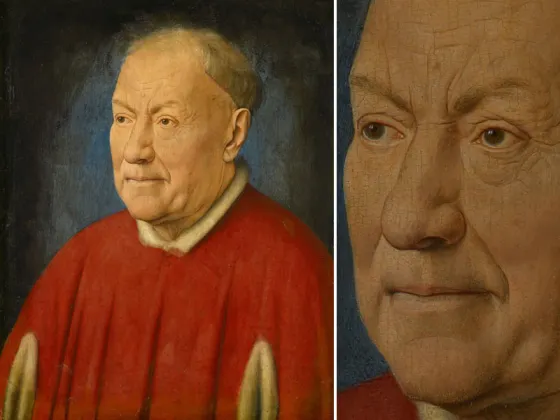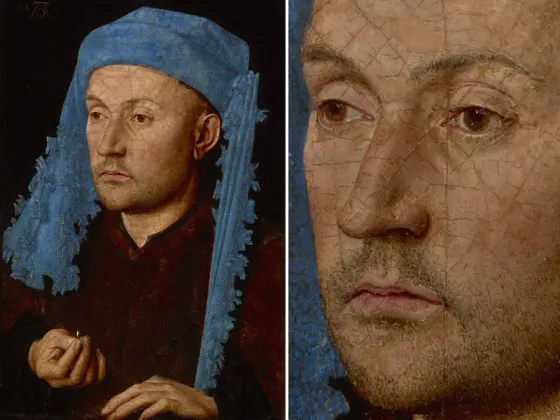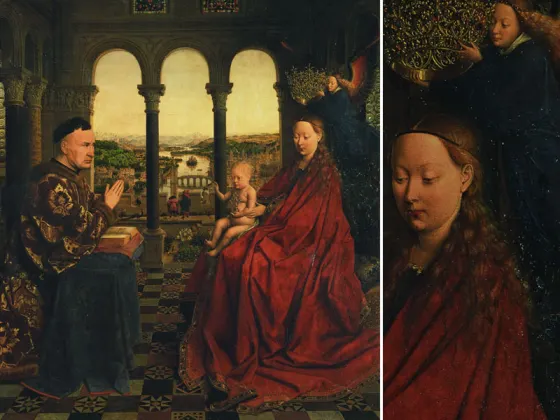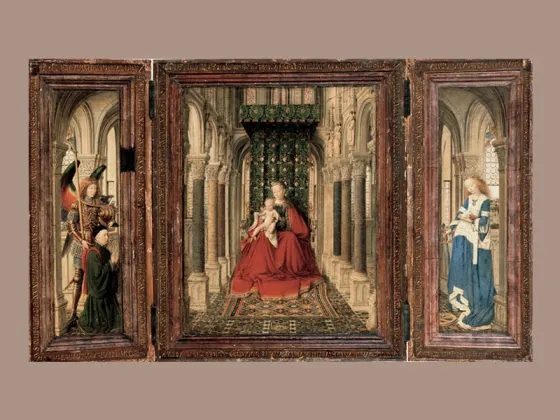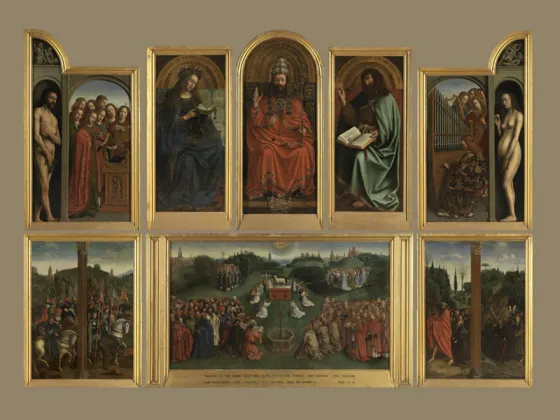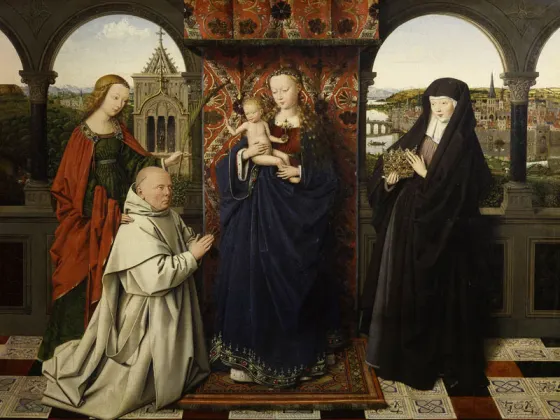扬·凡·艾克《戴蓝色头巾的男人肖像》

局部细节 / DETAILS
作品简介 / INTRODUCTION
作者:Jan Van Eyck 扬·凡·艾克
标题:Man in a Blue Turban
日期: 约1430 - 1433年
风格: 北方文艺复兴
艺术类型: 肖像画
媒材: 油彩, 木板
地点: 罗马尼亚国家艺术博物馆
尺寸: 16.6 x 22.5 公分
《戴蓝色头巾的男人肖像》,早期的《珠宝商的肖像》或《戴戒指的人的人像》)是一幅非常小(22.5厘米x 16.6厘米,带边框)的油画,画的是一位身份不明的人,出自早期荷兰画家扬·范·艾克之手。
这幅画于1430年左右委托完成。它包含了许多范·艾克世俗肖像画的典型元素,包括略大的头部、深色平坦的背景、对男子面部小细节和纹理的法医关注,以及幻觉装置。在北方文艺复兴时期,艺术家们没有为他们的作品命名,就像任何身份丢失的保姆肖像一样,这幅画多年来一直吸引着通用的标题。长期以来,人们一直认为,这名男子右手中的戒指是他作为珠宝商或金匠职业的象征,因此这幅画的名字长期以来都是以这种职业的变体命名的。最近,戒指被解释为订婚的象征,各种艺术历史学家和出版物给出的头衔通常更能描述头饰的颜色或形式。
这幅画在19世纪末被认为是凡·艾克的作品,但这一点一再受到一些艺术历史学家的质疑,直到1991年的一次清理,红外摄影揭示了一个明显属于凡·艾克作品的绘画不足和处理油画的方法。
这名男子在四分之三的视图中,他的脸被从左边落下的光线戏剧性地照亮了。这种装置提供了鲜明的光影对比,并将观众的注意力吸引到了男子的脸上。他有一双棕色的眼睛,虽然他的表情冷漠,但也有忧郁的痕迹,尤其是在他的嘴角。他显然是贵族中的一员,穿着一件毛皮衬里的棕色夹克和一件黑色背心。他的头饰是一个监护人,有两个翅膀,垂在男人的肩膀上,一直延伸到胸部。布的边缘从火车的边缘看去有一种破碎的感觉。风帽采用从昂贵的青金石宝石中提取的颜料,颜色明亮而引人注目,使其具有明亮、强烈的色调。这顶头饰与范·艾克1433年的《一个人的肖像》中的头饰相似,但不那么奢华,远处的一个人戴着这顶头饰。这种类型的头饰在1430年代中期就已经过时了,很方便也很明确地确定了这幅画在那之前已经完成的年代。
Portrait of a Man with a Blue Chaperon (or Portrait of a Man with a Blue Hood, earlier Portrait of a Jeweler or Man with a Ring) is a very small (22.5 cm x 16.6 cm with frame) oil on panel portrait of an unidentified man attributed to the Early Netherlandish painter Jan van Eyck.
The painting was commissioned and completed sometime around 1430. It contains a number of elements typical of van Eyck's secular portraits, including a slightly oversized head, a dark and flat background, forensic attention to the small details and textures of the man's face, and illusionistic devices. Artists did not give titles to their works during the Northern Renaissance period, and as with any portrait of a sitter whose identity is lost, the painting has attracted generic titles over the years. It had long been thought that the ring held in the man's right hand was meant as an indication of his profession as a jeweler or goldsmith and so the painting was long titled on variants of such. More recently the ring is interpreted as an emblem of betrothal and the titles given by various art historians and publications since are usually more descriptive of the colour or form of the headdress.
The painting was attributed to van Eyck in the late 19th century, but this was repeatedly challenged by some art historians until a 1991 cleaning when infra-red photography revealed an underdrawing and methods of handling of oil that were unmistakably van Eyck's.
Prior to 1948, the panel belonged to the Brukenthal National Museum in Sibiu, Romania. That year, the new Communist regime seized the panel, along with eighteen others it considered the museum's most valuable holdings, and gave it to the National Museum of Art of Romania in Bucharest. At the end of 2006, in time for Sibiu's stint as European Capital of Culture, the works were returned to the Brukenthal Museum.
The man is shown in three-quarters view with his face dramatically lit by light falling from the left. This device provides both striking contrasts of light and shadow and draws the viewer's attention on to the man's face. He has brown eyes, and while his expression is impassive there are traces of melancholy, especially in the down-turn of his mouth. He is obviously a member of the nobility, being very well dressed in a fur lined brown jacket over a black undervest. His headdress, a chaperon, contains two wings which hang down over the man's shoulders and extend to his chest. The edges of the cloth are given a shredded look at the edges of their trains. The hood is brightly and dramatically coloured using pigment extracted from the expensive lapis lazuli gemstone to give it its bright, intense hue. The headdress is of a similar but less extravagant type to that seen in van Eyck's c. 1433 Portrait of a Man, and worn by a figure in the distance in his c. 1435 Madonna of Chancellor Rolin. This type of headdress was to go out of fashion by the mid 1430s, conveniently and definitively dating the painting as having been completed before then.
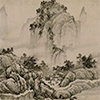 高清国画
高清国画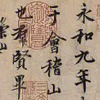 书法字帖
书法字帖 高清油画
高清油画





